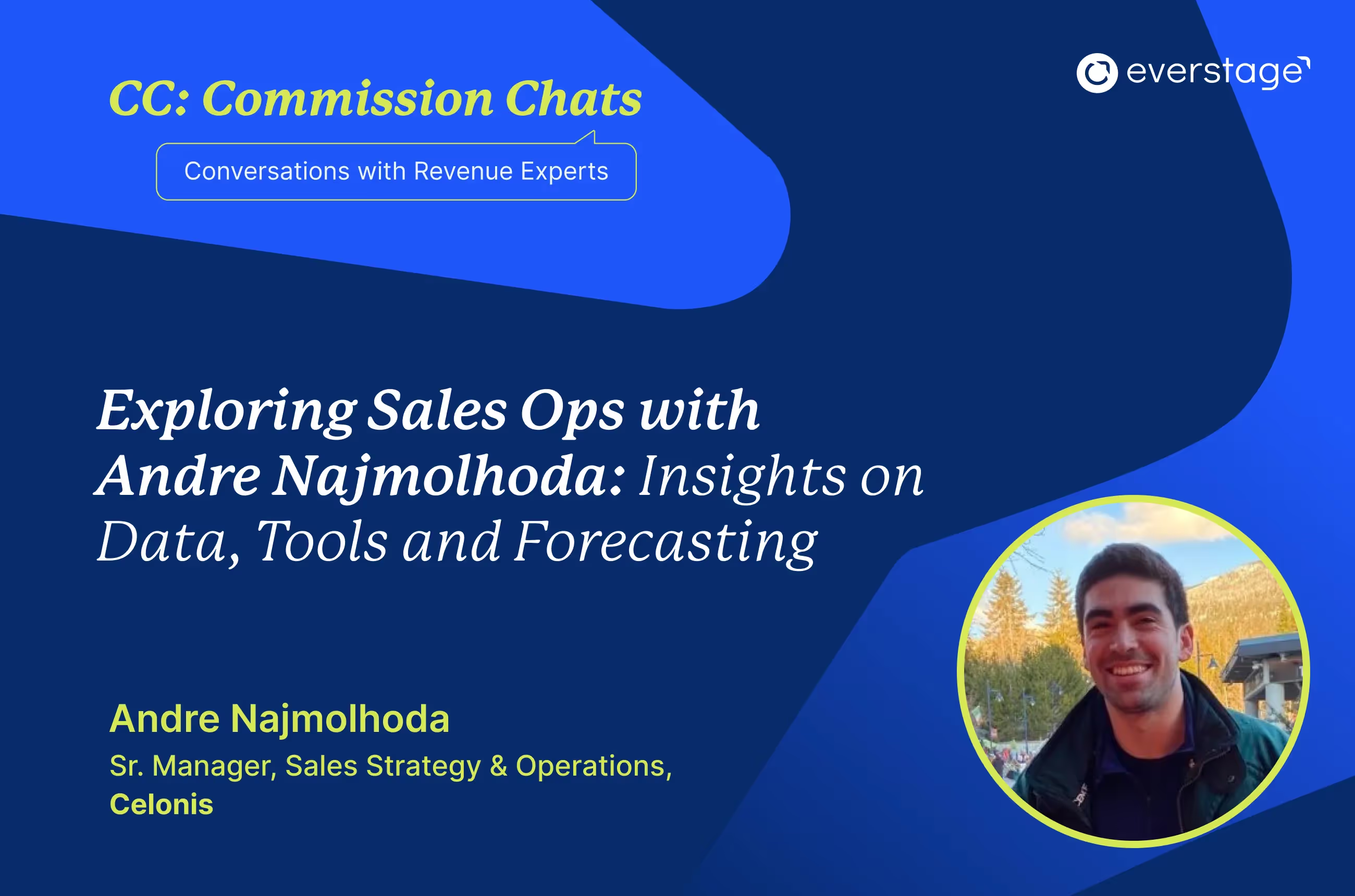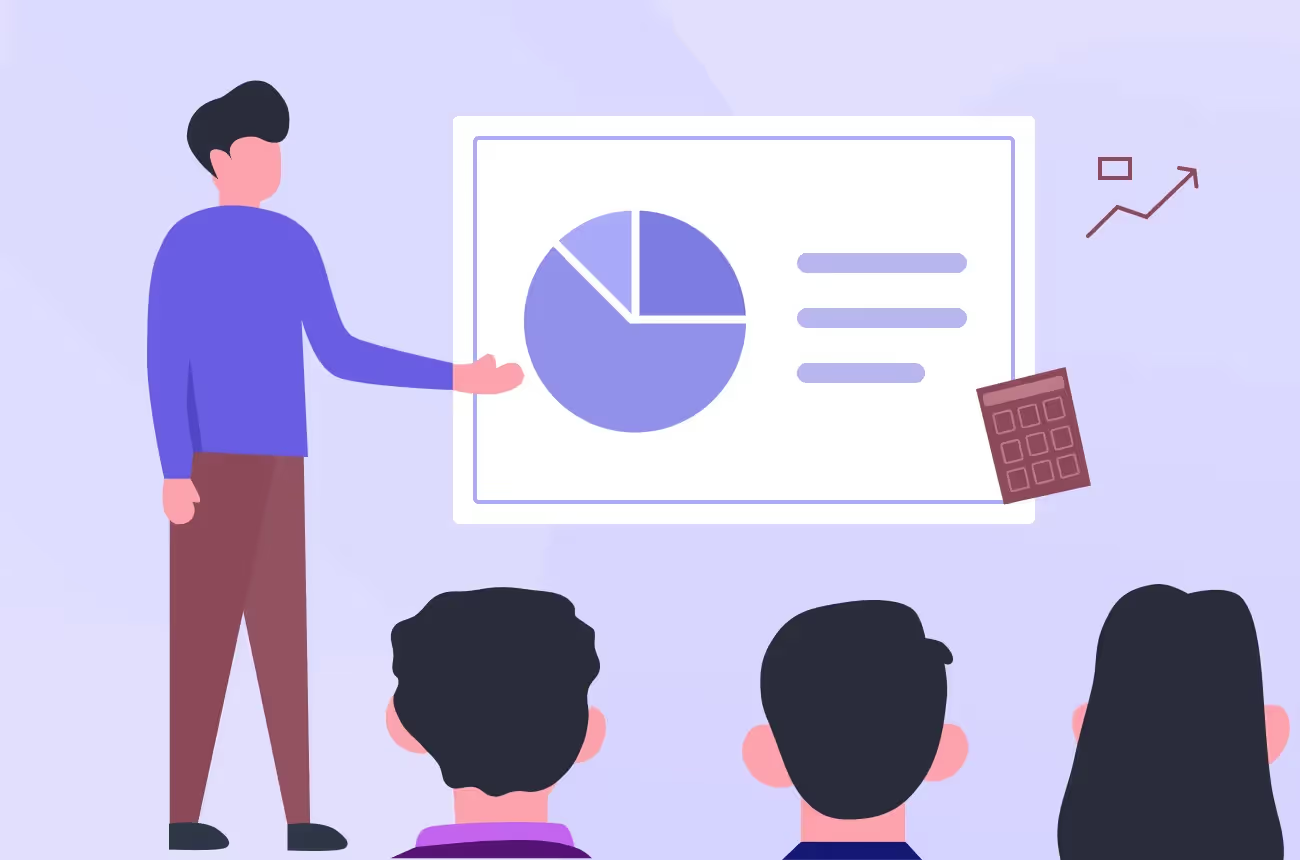Welcome to Everstage's ‘CC: Commission Chats’ – an interview series from Everstage featuring stories of world-class GTM leaders.
It all began at B-School when Andre's enthusiasm for sales led him to a couple of exciting internship opportunities.
Now, Andre is a Senior Manager of Sales & Operations at Celonis.
‘My experience in sales, tech, and finance has proven to be a valuable asset in my current role in SaaS Sales Operations.’, says Andre.
At Celonis, you'll find Andre in the thick of things on a variety of tasks, whether it is territory planning, pipeline reviews, or sales analysis.
In this interview of CC: Commission Chats, Andre talks about his journey, leveraging data effectively to improve sales performance, tools for improving sales processes, sales forecasting techniques, and many more.
Your journey from a BDR at Pinkerton and Gartner to a Senior Manager, Sales Strategy and Operations at Celonis is quite fascinating. Could you dive into it a bit more?
During my time in University of Michigan Business School, I was very involved in our Sales curriculum. That's how I got two internships in Business Development. Out of the two opportunities, my time at Gartner was particularly relevant to my current role. Gartner provides a platform for evaluating all sorts of tech vendors. Gartner also connects companies with industry leading analysts, helping them stay up to date on tech trends and the leaders in different emerging tech spaces. So, that was my first experience, where I got the basic exposure to the tech landscape and sales.
Coming out of college, I really wanted a more technical experience where I could apply the business fundamentals that I learned in school. I went into a finance role at Stout Advisory where I did corporate valuation services for a couple of years. At Stout I worked on a variety of valuation engagements, including goodwill impairment testing, and 409A and portfolio valuations. My favorite project there was the valuation of a private equity portfolio in SaaS and media companies.
After these stints in sales and finance with exposure to the tech market, I’ve been working directly at SaaS companies for the past four years in both corporate strategy and sales strategy & operations.
Now you're at Celonis, and I assume Celonis is approximately a 3,000 employee company. How does your typical day at work look like and what's your scope of work holistically?
Our day-to-day work keeps changing which keeps things interesting. It is a company with a few thousand employees that grew pretty exponentially even during COVID. We've had rapid headcount growth and set up new teams in sales while scaling with the rest of the company. To adapt in this environment, you really have to be nimble and be able to take on and balance so many different types of projects.
Our Strategy and Operations department at Celonis is set up very smartly, where we support different areas of the Go-To-Market business. We have different sales ops teams for North America, EMEA, and Rest of World. We also have different operations teams for our value engineers (who manage both customer success and sales engineering), ecosystem team, and more. For the past year and a half, I was solely focused on the Sales Ops of North America, working on a variety of initiatives including forecasting, planning, sales strategy and execution.
Over that time period we found an opportunity to verticalize our sales teams vs. using a geography-based approach so our sales reps can have more success by selling Celonis based on specific industry use cases. As a result, we now have sales reps and teams dedicated to specific markets such as consumer products, healthcare, manufacturing, etc.
This year in Strategy & Operations, we've also transitioned to more of a business partnership role. The team consists of four sales ops managers. Now that we have set up all these vertical sales teams, we have six sales VPs in North America and we partner with them directly. I'm partnered with our consumer products and retail sales VP and I'm also partnered with a segment that we call growth, which is essentially our mid-market business.
Every day, I spend a lot of time in operational cadences with those sales VPs. We do weekly forecasting, pipeline reviews, monthly/quarterly business reviews, and more to ensure that we are identifying new sales opportunities and executing against our annual sales plan.
Each week, I dedicate some of my time to focus on the North America region. This helps us act as representatives of our business units and provide a forecast for how sales are shaping up in the region. And then, I do a lot of day to day stuff in terms of special projects. This may include performing ad hoc growth strategy recommendations, setting up new sales teams and incentives, coordinating sales analyses across departments to ensure consistency, etc.
How do you use your sales data to help sales reps perform better? What's your strategy for leveraging this data effectively?
We mainly focus on our sales funnel and keep a close eye on what's happening in the pipeline. Our sales funnel has six stages. The first stage is about profiling the opportunity, and we don't consider that as entering our true sales “pipeline” at that point. Once it crosses stage one, it becomes part of our pipeline, and then it goes through the next stages, and finally into stage six.
What we often see is that once opportunities get into that first discovery stage, their chances of turning into a win are pretty low. Usually, it's a BDR passing a lead to a sales rep, and when they have that initial meeting, it's a coin flip if the customer will move forward or not. Sometimes, an opportunity can sit in that stage, it can progress quickly through future stages, or if a sales rep finds out a different use case to sell into, they may even start a new opportunity beginning at stage zero.
It's very helpful for us to know the overall coverage in our funnel. But what we found is that, once the opportunity reaches the fourth stage, the likelihood of conversion is much higher. As such, we like to look at the coverage of opportunities in the last 3 stages of our sales funnel vs. AE quotas as an indicator of future performance. At times, we take into account the late-stage pipeline and adjust it based on the anticipated conversion rates to get a general overview of how our sales reps are likely to perform. This serves as a good baseline but typically involves manual judgement to finalize a forecast given the binary nature of enterprise software sales. When dealing with longer sales cycles and larger deal sizes, you have to factor in multiple data points, quite often involving qualitative customer conversations, in order to forecast future sales. This happens because decision makers might want to explore additional use cases / success criteria, a company might not be able to get off-cycle budget approved for software spend, and much more.
On the other hand, the mid-market team can have a somewhat more quantitative way of analyzing the funnel given smaller deal sizes and higher frequency of transactions. In this market we typically look for the number of Land vs. Expand opportunities in the funnel and what percent of opportunities are progressing through the sales stages in line with average time spent on deals we have won in the past.
We also have a series of Salesforce fields on each opportunity that are very crucial for us during forecast calls. When we want to get into the nitty-gritty with individual sales reps, we pull up the opportunities and dig into the stories behind each one. We then decide whether we think it's likely to close or not, and that helps us come up with a forecast category that fits each opportunity.
What are the tools that you find most useful for managing and improving the sales process?
Our source of truth starts with Salesforce. Basically, we spend a lot of time in a forecasting tab in Salesforce to see how everything (the sales funnel) is rolling up by sales region. It has all the layers of forecast judgement of what opportunities are being forecasted from an AE to a manager to a VP. That's one of our main tools.
We will use Excel to do complicated analysis, but for the most part, we use Google Sheets. Essentially, we make ad hoc dashboards for sales trackers in Google Sheets and will use extensions to plug into Salesforce or other data sources.
We’ve created simple dashboards where we can refresh the backup sales data on a weekly basis. This helps us identify trends and analyze our Salesforce data in mass, or highlight where there may be discrepancies in the data.
That is how we figure out if it's a sales insight or a possible hygiene issue. If there is a hygiene issue as per our Google Sheets, we'll work with our process and tools team to continuously fix our Salesforce instance and keep things clean.
And the next tool we actually use is our own product. The first and the second tool we use are the building blocks. Once we have that building blocks solid, we will use Celonis to do our most advanced and dynamic analytics. One product we have is our Opportunity Management Dashboard, which has all sorts of business intelligence dashboards for the state of the sales funnel including pipe generation, pipe stock, and pipe progression over time. It has AE participation dashboards, territory planning, sales performance by quarter, month, year. The product is flexible, allowing you to filter on different sales teams, timeframes, and much more. The product also has forecasting dashboards, which is our go-to tool for weekly forecasting with the sales executives at Celonis.
You also mentioned about sales forecasting. So what techniques do you use to forecast and how do you make it more accurate?
I would say it's similar to one of my previous answers on analyzing rep performance. A lot of what we find for the enterprise sales cycle deals is that they can be very binary. As such, you need to stay on top of deal updates and have weekly, sometimes multiple times a week, forecast calls with the direct sales regions. The sales regions will have weekly one-on-ones with their sales reps and their managers to discuss the sales funnel.
And then that rolls up to a once a week call at the North America level where we will provide our sales forecast for the quarter. We spend time in the Celonis product directly reviewing opportunity-by-opportunity with a variety of deal-specific Salesforce fields that tell a story. We have our opportunity record that has all details like the potential ARR of the deal or ACV, when it's going to close, what stage it's in, and then a variety of other fields like, Are we connected with those key stakeholders? What are the next steps on this opportunity? What are the manager's notes of that AE on the opportunity and how are they viewing it?
Then we have the three forecast fields on the opportunity-level, including forecast categories that are owned by the AEs, managers, or VP / theater level. When the Account Executives make a commitment for a deal, that's essentially their forecast. If they mark it as 'best case', it means it's highly likely to close. When we gather all these opportunities from the pipeline, we also pay attention to the 'manager forecast' field. They have their own layer of judgement. And in a typical quarter, they'll be a little bit more conservative than the sales rep.
Imagine the sales reps in that region are committing a total of $5 million for the quarter. On top of that, they have about another $2 million in the 'best-case' scenario, so that's a total of $7 million between the 'commit' and 'best case' categories. Additionally, there's another $5 million in the pipeline.
Now, if we move up to the manager level and look at the numbers there, let's say the managers are committing to $4 million in deals, but they’re putting the remaining $3 million in the 'best-case' category. There’s another $5 million in the pipeline. Then that is their roll up of what they commit to.
But separately, let’s say the manager calls a forecast and that forecast might be 4.5 million at the start of Q3. As we enter the quarter, managers take a closer look and say “Hey, my deal is walking up to a commitment of 4 million, but I'm forecasting 4.5 million because these two deals in the best case are very promising. We're not committing them yet, but they might close.”
But over the course of a quarter, there are these binary deals in movement where the deals might move around slightly, but the managers will be held accountable to their forecast or commitment of that 4.5 million. At the end of the day, the leader responsible for North America in that specific region might decide to commit $4 million instead of $4.5 million, just to be a bit cautious. They'll then add up these figures from all the sales regions to present the overall North America sales forecast to the CEO.
That was a lengthy answer, but that's how our process works. And there are usually deals that will come in or out to bridge the gaps if something happens.
AI seems to be all over the place these days. So with the advent of this digital disruption, how do you stay up with the current trends and the best practices in sales ops?
I probably have more work to do learning how to leverage AI in the best way possible to predict sales performance, but I am interested in staying up-to-date on how other sales ops professionals are doing it. It is hard to leverage public AI tools to do sales forecasting as it would rely on internal / confidential sales data. Typically, I will use AI just to either proofread or help structure executive level emails and stress test my own ideas that do not contain confidential information.
I’ve seen our sales reps use AI to sift through company reports and extract insights. These insights help them draw connections between our product's use case and the company's initiatives mentioned in their annual or quarterly statements. Our sales reps are actually using AI to assist them in jotting down notes during calls. It helps them capture key next steps and important takeaways from their sales conversations so they can be present in the conversation. From a sales ops perspective, I think we have a bit more to go to figure out how we best use it.
I completely agree with you about the importance of confidentiality. With your extensive experience, I'm sure you would have encountered quite a few tough situations. Could you recall and share some of these challenges and how you managed them?
There are a few challenges that come to my mind. Sometimes the task might seem very daunting or takes a lot of different moving pieces. For example, restructuring our sales team from a geography based approach to industry sales teams was like a two year planning process. It involved getting approval from multiple stakeholders, hosting presentations on GTM strategy and market coverage, people moving to new jobs in order to build a new sales org, etc. I would say basically break things up into two week sprints or weeklong sprints, where you have to break down a large term project into bite sized chunks. And then identify what's in your control, where you need approval, and where you can get help.
So we had a lot of talented people who were involved in the planning process. As we reworked things to an industry approach, we needed to analyze our data in a different way and clean up our understanding of industries. So we were able to leverage our Salesforce teams to refresh our industry data. Another person who was part of the planning process also suggested a different approach to how we handle account hierarchies at Celonis. Previously, we divided single accounts among various regions, resulting in three sales reps for one account in some cases.
Right now, we are breaking up into only one account based on what the parent account is in their industry, resulting in only one sales rep. We've got a Salesforce team that's helping us clean up our industry data, someone else working on defining sales hierarchies, and another team member creating planning templates for us to build future sales territories.
My role in all of this is to be liason and collecting all these inputs. It's actually been quite a time-saver. I use those inputs to carve out the territories and also handle presentations, people change management, and go-to-market strategy after analyzing the data.
I guess the short answer is it takes a village. Break up things in bite sized chunks and utilize the team around you as it makes sense because everyone's swimming towards the same goal.












